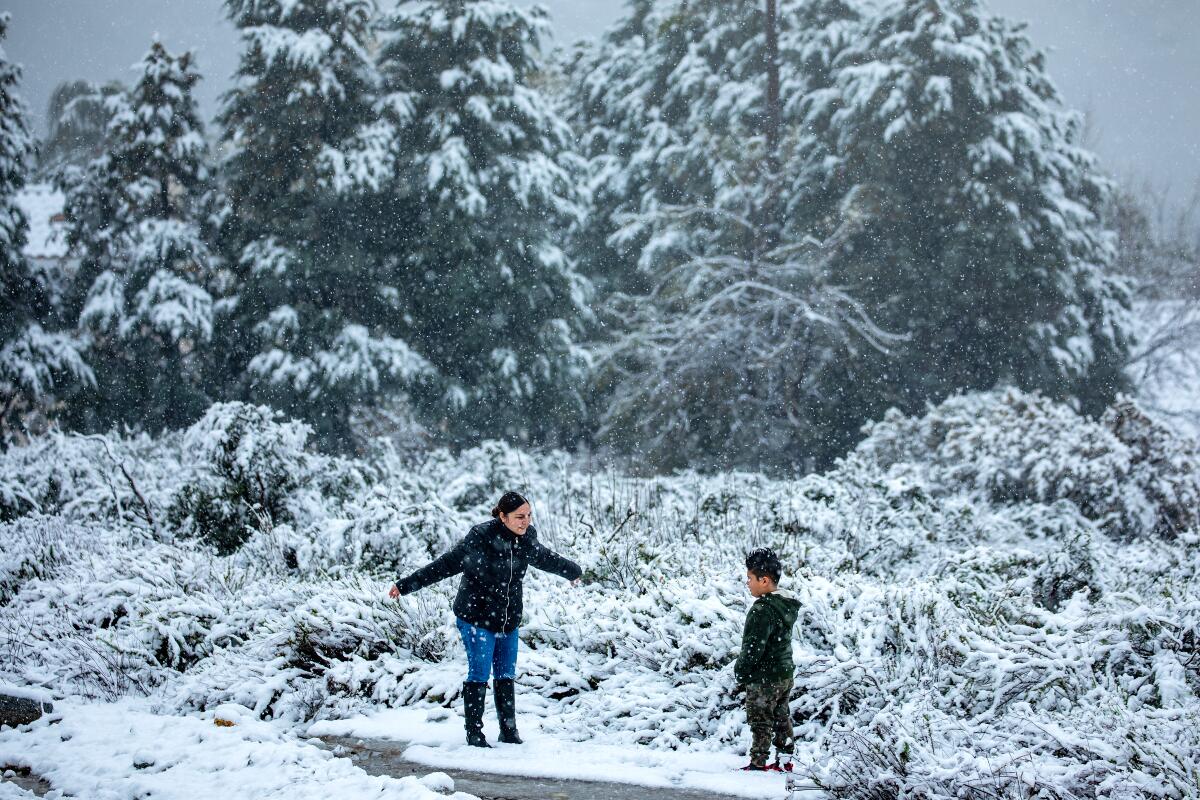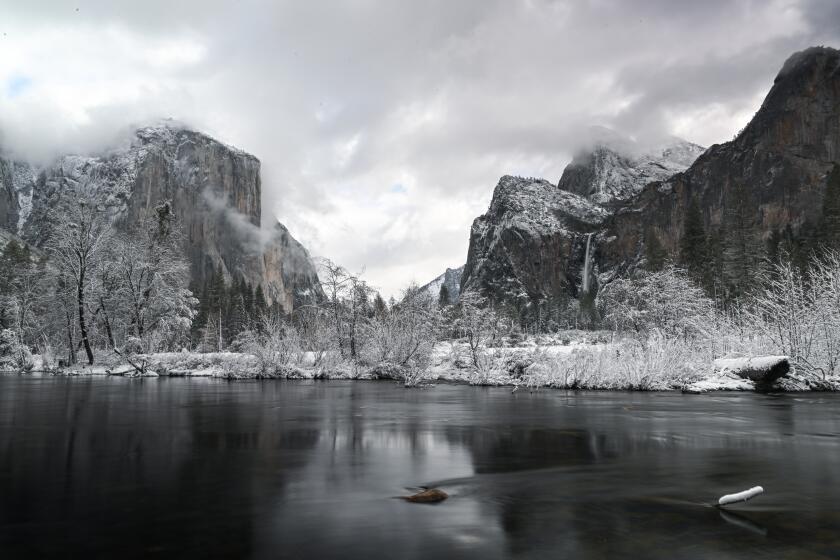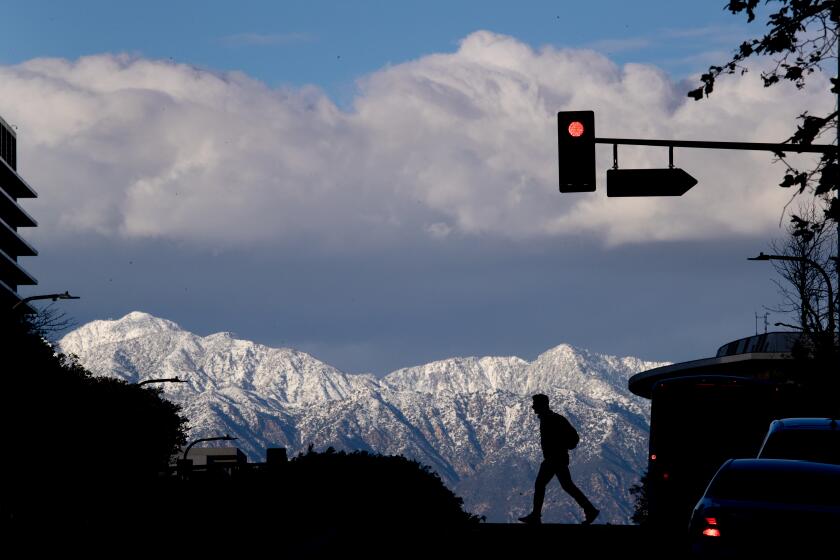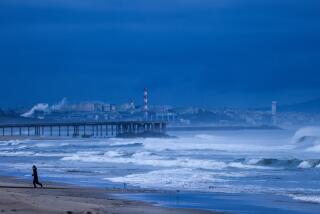Epic winter storm turns Southern California snow white; more rain and snow on the way

Vandi Mahoney watched television images of snow falling across parts of Southern California the last few days as a massive winter storm moved through the region, but on Sunday she just had to see it for herself.
Standing at Kenneth Hahn State Recreational Park, the 25-year-old was in awe of the snow-covered Santa Monica and San Gabriel mountains. Peak after peak was blanketed in sparkling white snow under a sunny blue sky and puffy clouds.
“Usually you can see far away a little hint of snow, but this is, wow. It’s not the scenery of the snow itself but just the beauty of Los Angeles: the clouds, the sky, the sun, and on top of that we got these snowy mountains, too,” she said.
“This is why I love L.A.”
Residents across the Southland woke up to an icy wonderland Sunday morning, the result of an frigid winter storm that broke rainfall records and scattered fresh powder at elevations as low as 1,000 feet across the normally warm, sun-drenched region. Mountain communities were slammed by intense snowfall, with Mountain High ski resort clocking an impressive 93 inches of snow.
All roads inside the park have been restricted to administrative use only.
The unusually strong winter storm closed the Grapevine — a vital trucking artery across the state — for days, knocked out power to thousands of utility customers, prompted rescues and affected air travel. Lighter showers are expected through Wednesday, but nothing like those that have passed. For many Angelenos, these intense storms served as a reminder not to underestimate Southern California’s capacity for wild weather.
Those who say California doesn’t have seasons should think again, said Rich Thompson, a meteorologist with the National Weather Service in Oxnard.
“I think this kind of proves the point that, yes, we do get weather out here,” Thompson said, adding that it just “may not happen as much as other parts of the country.”
The storm, which originated in the Gulf of Alaska, tapped into an atmospheric river system — a powerful plume of moisture that can deliver large amounts of precipitation. Sunday marked a short reprieve from the wet weather, with another series of storms set to hit during the week.
But Sunday morning, dozens of photographers packed into Kenneth Hahn State Recreational Park to snap shots of the glistening mountains. The parking lot was packed with people in cars waiting for a spot to open up.
Barbara Garcia, 49, of Santa Monica said that in the 20 years she’s lived in Los Angeles she’s never seen so much snow. She stopped at the park in search of a view of the city and the mountains.
Scenes from across Southern California, where a powerful winter storm dumped heaps of snow and record-setting rain.
“I was going to go on the freeway and get close, but I thought this was more panoramic,” she said. “You got the whole enchilada.”
After the weekend storm dumped as much as 7 feet of snow on some mountains in the region, ski resorts were encouraging people Sunday to take advantage of the lull in snowfall.
“It’s a beautiful bluebird day,” said Mammoth Mountain spokesperson Lauren Burke.
Since Wednesday, Mammoth Mountain had received between 4½ and 5½ feet of snow. Burke said the resort was bracing for another storm to touch down Sunday night, likely bringing another 4 feet.
Both Bear Mountain and Snow Summit were open Sunday after receiving a foot of snow over the course of 24 hours. But road closures meant that only locals could access the fresh powder.
Big Bear spokesperson Justin Kanton said the resort hasn’t made a determination yet on whether the snow brought by this week’s storm will lead to an extended season.
“We’ve had seasons where we get a bunch of snow in January and February and it can warm up dramatically in March,” he said. “We want to wait and see what the snow is going to do for us.”
Lynda Sandoval, 32, was excited as she shoveled the deep snow that had accumulated at her house in Pinon Pines, a tight-knit mountain community at the top of the Grapevine near Tejon Pass. It was the first time she had been able to “escape” from her house since heavy snow began falling on Thursday — and kept coming through Saturday, she said.
“Cabin fever is real,” Sandoval said. “So it feels good to actually see some of my neighbors.”
Utility crews worked through the weekend to restore power to thousands of customers affected by the storm. A Los Angeles Department of Water and Power employee was injured while working in the Valley on Saturday. He remains in intensive care, according to the utility.
Hannah Wachs’ family in Tarzana was still without electricity Sunday night, 45 hours after they lost power on Friday. The Wachses sent their three daughters — ages 11, 14 and 16 — to friends’ homes so they could stay warm and get homework done.
“I think it’s about 55 degrees in the house, as cold as it is outside,” Wachs said. “A lot of streetlights in my neighborhood are out, too — I wish they would fix that before they ever fix my house because that’s just dangerous. I would think those would be LADWP’s highest priority.”
For communities that didn’t see snow, rain was plentiful.
On Sunday morning, Los Angeles Fire Department crews took two adults who were experiencing signs of hypothermia and their pet cat to the hospital. The group was camping in a vehicle in a remote section of the stormwater-filled Tujunga Wash at the base of the San Gabriel Mountains.
At least two homes in the 400 block of Paulette Place in La Cañada Flintridge were damaged by debris flow and evacuated, according to CBS Los Angeles.
More than 10 inches of rain fell in Woodland Hills, while Bel-Air received 6.76 inches of precipitation as of Sunday morning. Downtown Los Angeles saw 4.49 inches — a little more than 2 inches each on Friday and Saturday. It was only the sixth time since 1877 that downtown received that much rain on two consecutive days, according to the National Weather Service.
Though winter isn’t over, and a renewed dry spell could still materialize in March, the significant storm and the systems that drenched the Golden State in January have defied expectations of a dry winter. Climatologists say the storms will probably be beneficial for drought recovery after years of prolonged dryness.
Downtown Los Angeles has received 18.28 inches of rain since Oct. 1, which marks the beginning of the water year. Last year at this time, only 10.42 inches of precipitation had fallen in the area, according to the National Weather Service.
The storms have also helped bolster the state’s snowpack, a vital component of the state’s water supply. As of Friday, the Sierra snowpack was 173% of normal for the date.
It may get another boost this week.
A series of weaker storms is expected to drop about an inch of rain across the Los Angeles area through Wednesday. Snow will also be likely, just not at the same low elevations as the weekend system.
“It’ll be another shot of some rain and snow, but nothing like we just experienced,” said Thompson, the meteorologist.
The National Weather Service issued a winter storm warning ahead of forecast blizzard conditions for towns in and around the Sierra Nevada range and issued a blizzard warning for parts of the Sierra, including Interstate 80 and Highway 50, going into effect early Monday morning and lasting until early Wednesday.
In East Hollywood, street vendors were celebrating the brief break in the rain.
Along Vermont Avenue, merchants laid their wares on the sidewalk, hoping to make some cash before the next storm arrived. Most of them said they were grateful for the rain despite its effect on business.
Eduardo Rodriguez, 43, said he comes out on weekends and lost a day of selling soap, shampoo, perfume, cologne and toys.
“It’s OK, I’m happy to see the snow on those mountains,” he said. “More snow means more water for us all, and that’s needed.”
Sandy Grimaud, 35, who was visiting Los Angeles from New Jersey with her husband and three children, wasn’t as pleased about the soggy conditions.
The family’s Warner Brothers tram ride was cold and wet. They had only a few hours to enjoy Disneyland before they had to leave the “Happiest Place on Earth” and head indoors because of the rain. They couldn’t even get a decent view of Los Angeles—the low clouds made it impossible, she said.
“I started to regret my vacation,” she said, pushing her two youngest children in a stroller around Griffith Park.
But, in a stroke of good fortune, the airline offered her and her family an extra day in Los Angeles if they would give up their seats. Grimaud saw sunshine in the forecast and jumped at it.
On Sunday, the family wandered around Griffith Observatory after her 8-year-old son, Miles, requested they check out the Hollywood sign. The views of the city and mountains made up, somewhat, for the wet and cold days before.
“It’s good to be able to take some memories,” she said.
Nearby, Fabian Zambrano, 58, stood next to his daughter, Odile, 26, who was taking a selfie with the Hollywood sign in the background. Zambrano’s wife, Ivonne Tacoaman, 52, was also taking in the view.
The Ecuadorian family were on the fourth day of their vacation in Los Angeles. Zambrano said it was not the best trip given the weather, but it was still enjoyable. The break in the storm was a blessing, he said.
Looking at the views, Tacoaman said it’s understandable why people fall in love with Los Angeles.
“You have the ocean on one side, the mountains on the other, “ she said. “You can see both at the same time, it’s spectacular.”
More to Read
Sign up for Essential California
The most important California stories and recommendations in your inbox every morning.
You may occasionally receive promotional content from the Los Angeles Times.
















